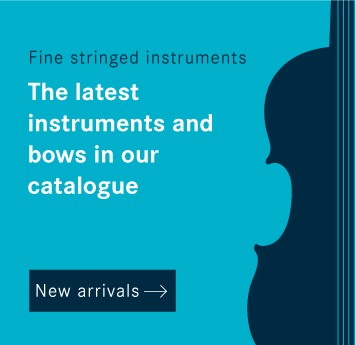The story of Bruce Carlson and Bernard Neumann involves finding Stradivari in the midst of the Pacific and how their internationally renowned workshop was linked to World War One.
Bruce Carlson
The history of the violin-making workshop of Bruce Carlson and Bernard Neumann – one of the most highly esteemed businesses in Cremona, Italy, the cradle of the modern violin – began in the middle of the Pacific. A 20-year-old from Flint, Michigan stationed at the US naval base in Guam, Carlson was at the army library when he came across a book that would change his life: the Hill brothers’ standard classic about Antonio Stradivari. Enthusiastically he began to use his free time on attempts at violin making, and he continued these efforts back in his home town in 1971 under the guidance of Felix Wickstrom. In 1972 Carlson commenced his training at the violin-making school of Cremona even though – as he himself said – before that time he barely could find Italy on a map. During an intermezzo with Hans Weisshaar in Los Angeles, he further honed his knowledge of restoration work between 1974 and 1977, whereupon he promptly returned to Lombardy to complete his degree in Cremona in 1978. It was there that he also started a family and opened a workshop.
Perhaps it is because of his thoroughly un-Italian name that Bruce Carlson began focusing his work on restoration early on instead of trying to establish a profile for himself with new instruments. After all, as he correctly assumed, international clients come to Cremona in search of truly Italian violins, and despite all of the faithfulness to historic Italian principles of violin making which Carlson feels bound to, having a Swedish-American name requires some explanation if nothing else. That said, working under an Italian nom de plume – a well-established tradition in the history of violin making – was never something he saw as an option, but over time Carlson ultimately became an expert who is highly esteemed in Italian and international professional circles, and he did so under his own birth name. He has created a lasting legacy in research and held many important roles: he helped shape the juries of major international violin exhibitions as a member of the scientific committee for the exhibition in honour of the 250th anniversary of Antonio Stradivari’s death, served as Charles Beare’s assistant in writing his famous Stradivari book, and worked as a member of the scientific committee for the major Guarneri exhibition in 1995. In his work at the Museo Stradivariano in Cremona, he has successfully restored numerous top-tier historic instruments, including the famous “Cannone” by Guarneri del Gesù; multiple generations of young luthiers have been influenced by his restoration courses.
Bernard Neumann
Bernard Neumann, Bruce Carlson’s professional partner, also had quite a journey from his home country of Canada to his adopted home of Cremona, and the journey began with his grandfather’s tales of being stationed in Brescia as a soldier in the First World War. His grandfather had the opportunity to explore Cremona as the birthplace of the great Antonio Stradivari’s work. In addition to the romantic vision of the distant Italian town, Neumann cites another early influence which gave his work more humble roots: he regularly did woodworking thanks to the encouragement of his father, who tirelessly built on and around his family’s house. After countless hours of increasingly detailed woodworking, Neumann gradually made his way to studying at the Cremona violin-making school, where he met Bruce Carlson. The two have worked together since 1986 and founded Carlson Cacciatori Neumann & C. in 1991.
Even though both masters certainly had many points in common because of their training and their decades of working together, important differences can nevertheless be seen in their approaches to violin making – an artistic tension which has certainly had a positive impact on the major international success of their workshop. Unlike Carlson, Bernard Neumann came to violin making via playing the instrument, and he discovered that being at the workbench allowed him to explore opportunities in artistic expression which suited him best. As a result, Neumann emphasizes that the work of a luthier is defined not only by multi-facetted artisanry but also by a constant shift between phases of withdrawing to engage in contemplative work and an exchange of ideas with musicians, colleagues and experts. Correspondingly, Bernard Neumann interprets making a violin as a process in which each step is designed and implemented by one and the same person. It starts with the development of a musical idea based on both a luthier’s previous work and on the artistic discussions they participate in; it continues into the process of selecting the woods and ranges all the way to the final varnishing. And here Neumann primarily works “for himself” in the sense that he makes all of his decisions solely in the context of his own oeuvre and does not accept commissions. He regards it as a source of great joy when an instrument he crafted becomes a major figure in a musician’s life.
Carlson & Neumann Cremona
 In keeping with their different and complementary interests, talents and experiences, Bruce Carlson and Bernard Neumann’s jointly run workshop has become an international point of contact for musicians; there clients find luthier and restoration services offered at the highest standards as well as interesting newly crafted instruments. In addition to the classic canon of restoration methods, Carlson and Neumann also work with scientific approaches such as UV light and x-ray analyses. With the help of dendrochronological and nuanced endoscopic research, the two masters have a solid foundation for planning complex restoration and conservation work. In doing so, they can draw upon their outstanding training and extensive experience in classic techniques, and nowhere is this tradition as much at home as it is in Cremona.
In keeping with their different and complementary interests, talents and experiences, Bruce Carlson and Bernard Neumann’s jointly run workshop has become an international point of contact for musicians; there clients find luthier and restoration services offered at the highest standards as well as interesting newly crafted instruments. In addition to the classic canon of restoration methods, Carlson and Neumann also work with scientific approaches such as UV light and x-ray analyses. With the help of dendrochronological and nuanced endoscopic research, the two masters have a solid foundation for planning complex restoration and conservation work. In doing so, they can draw upon their outstanding training and extensive experience in classic techniques, and nowhere is this tradition as much at home as it is in Cremona.
Related information:
Eric Blot and Italian violin making
On the life of the Tyrolean violin maker Jakob Stainer
Jérôme Thibouville-Lamy – J.T.L.
Useful links:
Library - text about the history of stringed instruments
Online catalogue | Premium violins, violas, cellos and bows (audio sound samples)







